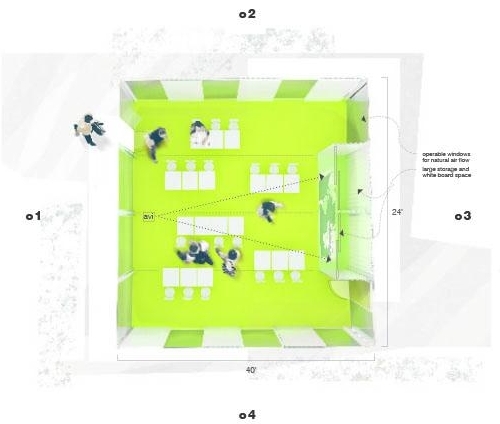VS Mobile Learning Environments
VS Mobile Learning Environment
In collaboration with VS America
CLIENT: TBD
LOCATION: Mobile
SIZE: 640-960 SQ FT
OPENING: Concept package completed in 2009
PROGRAM: Education
classroom in a 'box'
To understand the advantages and disadvantages of the mobile classroom in the digital age, one might first observe the traditional classroom.
Most schools were constructed in the 1970’s, and are therefore in major need of repair and technological and environmental adaptation. They are also incredibly inflexible,and these traditional layouts limit the students and teachers.The existing classroom model can most commonly be separated into three categories: a one-wall lecture typology, a two-wall lab typology, and a centric studio typology. The existing model most commonly falls in the category of a one-wall lecture room. Teacher stands in front, children face the teacher with very little flexibility in desk arrangement. In the two-wall lab typology, there is a bit more flexibility in how groups of students may be arranged to engage with the teacher, material, and other students. In the centric studio typology, flexibility is highest, as clusters or individuals may be arranged more easily. The goal is to go beyond these traditional typologies, and to maximize the flexibility within our mobile classrooms by allowing for a broad range of furniture arrangements, and implementation of advanced technology. This will allow a more dynamic learning environment, one where students become engaged with their teachers, peers, and resources.
In re-conceptualizing the mobile classroom, we aim to eliminate these common flaws in their design and usage. Mobile classrooms have the potential to react to the environment and context in a far more engaging and individualized way than many existing schools allow. What are forced to become solid walls in a traditional classroom may become flexible windows/screens/panels in a portable classroom. This automatically eliminates the traditional need for enclosure and containment, perhaps allowing the classroom to engage in its surroundings in a much more contextual way. Not only may there be economic and environmental advantages to a well-designed temporary classroom, but there are other missed opportunities that may be advantageous to the transformation of education in the digital age. Disintegrating the boundary between child-to-school, school-to-school, and school-to-environment relationships is key. More flexible connections between teachers, students, and classrooms may be made physically, visually, and even virtually.





